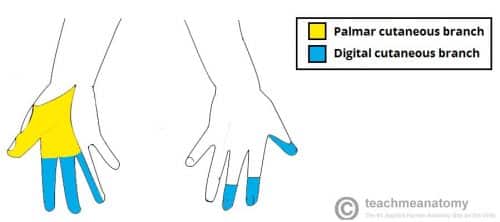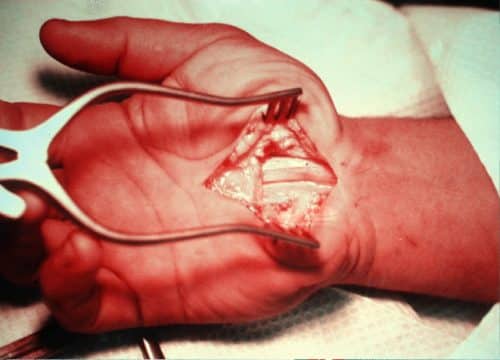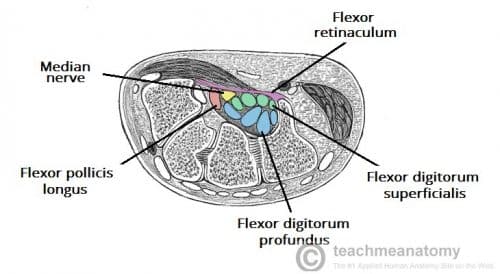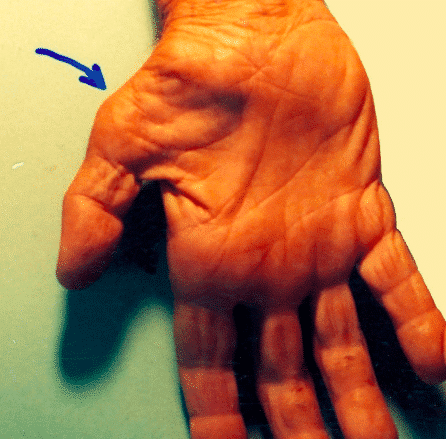Carpal tunnel syndrome (CTS) is a condition involving a compression of the median nerve within the carpal tunnel of the wrist, due to a raised pressure within this compartment.
Compression of the median nerve leads to symptoms of pain, numbness, and paresthesia in the lateral 3½ digits.
CTS accounts for 90% of all nerve compression syndromes. It is more common in women and has peak incidence between ages 45-60 (only 10% of CTS cases are in patients under 30 years of age).
In this article, we shall look at the risk factors, clinical features and management of carpal tunnel syndrome.
Risk Factors
The main risk factors for developing carpal tunnel syndrome include female gender, increasing age, pregnancy, obesity, and previous injury to the wrist.
Carpal tunnel syndrome is as associated with other conditions, such as diabetes mellitus, rheumatoid arthritis, and hypothyroidism.
Individuals who have occupations involving repetitive hand or wrist movements (e.g. vibrating tools or assembly line work) are also potentially at increased risk of CTS.
Clinical Features
Patients with carpal tunnel syndrome typically complain of pain, numbness, and/or paraesthesia throughout the median nerve sensory distribution.
The palm is often spared, due to the palmar cutaneous branch of the median nerve branching proximal to the flexor retinaculum and passing over the carpal tunnel.
Symptoms are typically worse during night and symptoms can often be temporarily relieved by hanging the affected arm over the side of the bed or by shaking it back and forth.
On examination there are often no visible findings during early stages of CTS. However, sensory symptoms can be reproduced by either percussing over the median nerve (Tinel’s Test) or holding the wrist in full flexion for one minute (Phalen’s Test).
In the later stages of carpal tunnel syndrome, there may be weakness of thumb abduction (due to denervation atrophy of the thenar muscles) and / or wasting of the thenar eminence (Fig. 2).
Differential Diagnosis
- Cervical Radiculopathy
- C6 nerve root involvement may produce pain or paraesthesia in a similar distribution however will likely have an element of neck pain or symptoms involving the entire arm length
- Pronator teres syndrome (median nerve compression by pronator teres)
- Symptoms will also extend to the proximal forearm and sensation of the palm will also be reduced
- Flexor carpi radialis tenosynovitis
- This can be distinguished by tenderness at the base of the thumb

Figure 3 – Schematic of the cutaneous innervation of the branches of the median nerve.
Investigation
Carpal tunnel syndrome is a clinical diagnosis and is an evident pathology in most cases on history and examination
However, in the more uncertain cases, nerve conduction studies may be useful to confirm median nerve damage (however a normal median nerve conduction does not rule out CTS)
Management
Carpal tunnel syndrome can be treated conservatively initially with a wrist splint (commonly worn at night), which can relieve some of the symptoms by preventing wrist flexion. Hand therapy can also be prescribed.
Corticosteroids injections can be trialled. They are administered directly into carpal tunnel to reduce swelling and in turn symptoms. Some clinicians may also trials NSAIDs in an attempt to further reduce swelling, however there is limited evidence to support their routine use.
Surgical Treatment
Surgical treatment is undertaken in symptomatic patient, where previous treatments (splints and hand therapy) have not been successful.
Carpal tunnel release surgery (Fig. 4) decompresses the carpal tunnel, involving cutting through the flexor retinaculum, in turn reducing the pressure on the median nerve. This can be done under local anaesthetic and is performed as a day case.

Figure 4 – Release Surgery for Carpel Tunnel Syndrome
Complications of carpal tunnel surgery include recurrence, persistent CTS symptoms (from incomplete release of ligament), infection, scar formation, nerve damage, or trigger thumb.
However overall post-operative outcomes are good, with 90% of patients reporting improved symptoms afterwards.
Complications
Long-term untreated CTS can lead to permanent neurological impairment that will not improve with surgery.
Key Points
- Carpal Tunnel Syndrome is caused by compression of the median due to a raised pressure within the carpal tunnel
- Patients will typically complain of pain, numbness, and paraesthesia throughout the median nerve sensory distribution
- Diagnosis is typically a clinical one
- Patients will initially be managed conservatively, however some may have to undergo Carpal Tunnel Release Surgery if symptoms persist


